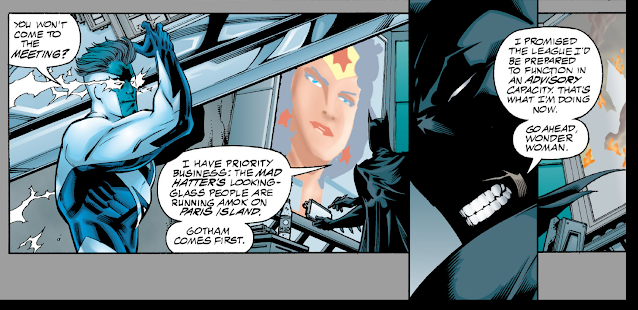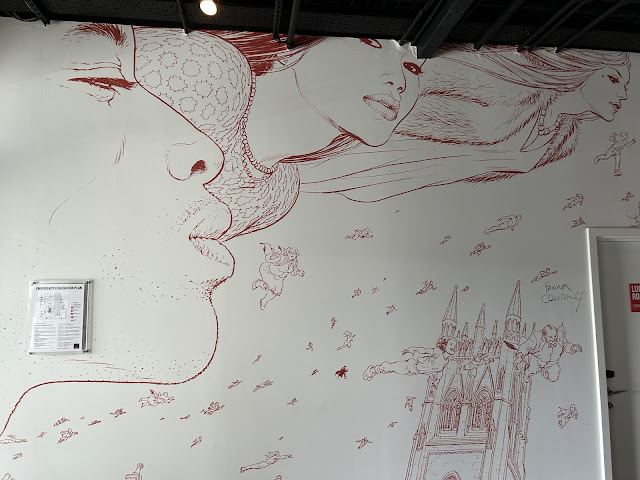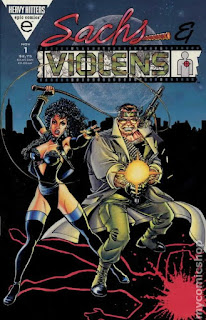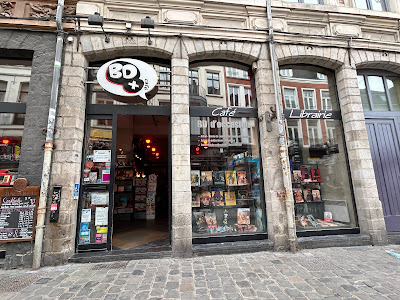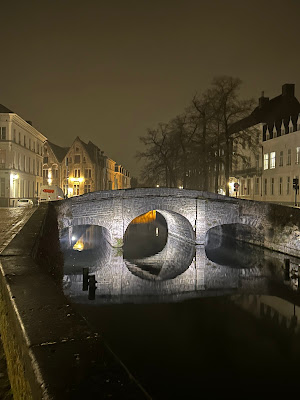The Give Me Comics or Give Me Death podcast is available from all your usual podcast providers, or see all episodes here
See the index for all entries in these Batman annotations here
In Part 1 of this recommended reading, I focused on the works by Grant Morrison that are particularly relevant to their Batman run. Now it's the turn of other writers and artists. Morrison reached back into the mists of time and used unexpected Batman stories for the basis of their epic - long forgotten tales, outlandish madcap stories that were excommunicated from continuity as they didn't 'fit' modern Batman, and plots and characters that neatly dovetailed with the saga that was to unfold.
Batman: Son of the Demon (1987)
Written by Mike W. Barr
Art by Jerry Bingham
This 1987 graphic novel is the purported origin of Bruce Wayne and Talia Al Ghul’s son, Damian Wayne, who plays a significant role in Morrison’s Batman run as a new Robin and (as shown in
Batman #666 and #700) ultimately takes over the mantle of Batman.
There are major discrepancies though between the story itself and the version put forward by Morrison. In
Son of the Demon, Batman appears to genuinely have feelings for Talia – or at bare minimum, be attracted to her – and agrees quite happily to a relationship with her. When she announces her pregnancy, he is delighted and prioritises the health of her and their unborn child over everything else. When Talia tells him she has lost the baby, Batman seeks revenge on the man he considers responsible (Qayin, who was at one time a surrogate son for Talia’s father Ra’s al Ghul). After leaving Talia (at her insistence) and returning to Gotham, he is clearly emotionally affected by the apparent death of his unborn child. As an epilogue to the tale, 9 months later, a baby boy is left on the doorstep of an orphanage and taken in by a childless couple. Left with the child is the necklace that Bruce gave Talia during their time together.
Morrison significantly rewrites history. When Talia asks Bruce if he remembers the night Damian was conceived, he replies, “
I remember being drugged senseless and refusing to co-operate in some depraved eugenics experiment.” No mention of the apparent miscarriage is made, and the inference is that Batman was unaware of Talia’s pregnancy. Furthermore, rather than being adopted anonymously by a random couple, Morrison tells of Damian being grown in an artificial womb and genetically modified, then raised by the al Ghul organisation The League of Shadows to be a future conqueror of the world. Damian says he was not ‘formally introduced’ to his mother until his 8th birthday, some two years before he meets his father.
Batman: Son of the Demon was never particularly considered an in-continuity tale, even upon its release, and although the idea of the child from this story was used in alternative universes or stories set in the future, Morrison’s Batman was his first introduction in the ‘main’ continuity.
Batman The Cult #1-4 (1988)
Written by Jim Starlin
Art by Bernie Wrightson
In this 4 issue mini-series – which clearly influenced
The Dark Knight Rises movie – a cult made up of the homeless and hopeless of Gotham mass in the city’s sewers launching vigilante attacks on criminals and politicians alike. There are clear links and influences of Morrison’s Batman run here. Batman is drugged and brainwashed into joining the cult, which is echoed in the scheme of Dr Hurt in
Batman R.I.P. The cult leader is a seemingly immortal man obsessed with Gotham, traits shared not only with Dr Hurt but also Brother Manfred from Morrison’s
Batman: Gothic. However, Morrison specifically links their Batman run with The Cult as this series sees the introduction of Miagani tribe, an ancient Native America tribe that lived in area that became Gotham City, and in the caves that became the Bat-Cave. All this also feeds into the general ideas that Batman has been subjected to drugs, gasses, and psychological attack, countless times over the years, and that the supernatural is an established aspect of Batman’s history.
Batman: Dark Kight, Dark City
Originally published in Batman #452-454 (1990)
Written by Peter Milligan
Art by Kieron Dwyer (and some lovely covers by Mike Mignola)
In this great little story Batman is led on a merry dance by the Riddler, who tricks Batman into committing a series of steps in a ritual to summon the demon ‘Barbathos’, culminating in the attempted sacrifice of Batman himself. It is suggested that this demon has possessed the Riddler and has been guiding his actions all along. The ending is ambiguous as it appears Batman releases the demon from where it has been trapped, along with the skeleton of the previous sacrificial victim, so despite surviving Batman may still have achieved the demon’s goals. Batman then gives the victim a burial in the Wayne mausoleum, next to his parents.
In flashback scenes we travel to 1793 where a group of men try to summon the same demon, via the sacrifice of the girl whose skeleton is found by Batman in the contemporary story. This summoning takes place in a cellar adorned with satanic symbols, with the group led by a Jacob Stockman and including a young Thomas Jefferson. A bat shaped creature appears – which the group assume to be the demon – causing the men to flee and trap the girl in with the creature, condemning her to death.
Morrison replays this scene in Batman and Robin #16 at the conclusion of The Return of Bruce Wayne storyline, as the revelations mount and the plot lines in place for the first two thirds of Morrison’s run come to conclusion. There are however some key differences. The demon being summoned is now referred to as ‘Barbartos’, named for a demon from The Lesser Key of Solomon, a grimoire from the mid-17th century. This ‘demon’ plays a key part in Morrison’s story and is revealed to actually be the Hyper-Adaptor, a creature/weapon sent by the New God Darkseid to pursue Batman through time, and the driving force of the events of The Return of Bruce Wayne. Furthermore, the sacrificial girl is not the only person left behind in the cellar as Stockman and friends flee – there is also Thomas Wayne, Bruce’s ancestor, who strikes a deal with ‘Barbartos’ granting him immortality. Thomas Wayne will surface years later as Dr Hurt, the principal antagonist for the bulk of Morrison’s Batman run.
The Black Casebook
Many of the plot points and characters that inform the first third of Morrison's run (often referred to as Batman R.I.P., but actually includes all the story up to and including those published under that title), are drawn from the oddball and bizarre Silver Age Batman comics that Morrison read as a kid. As they don't fit the character Batman became - and certainly not the modern silver screen version - they have been airbrushed out of history by DC Comics. They are not even available from their digital subscription service, DC Unlimited. However, to coincide with Morrison's successful Batman run, some of these were published together in The Black Casebook. Taking its title from Batman's own notes of his more esoteric adventures, it collected 12 otherwise unavailable tales. A few of the stories are included just to give an idea of the type of story that inspired Morrison, or examples of when Batman came under psychological attack or subjected to mind-altering gasses and chemicals (all of which plays into Batman R.I.P.), but the notable tales are;
Batman #65 - 'A Partner of Batman' (1951)
Written by Bill Finger
Pencils by Lew Sayre Schwartz
Robin is out of action after breaking his leg. Somewhat comically this comes not from battle with a super-villain, but Robin slipping on some oil and falling off a boat. Enter: Wingman. An unnamed masked adventurer from a 'northern European country' that fills in for Robin, whilst also being trained by Batman to be his counterpart in said unnamed nation. Robin becomes increasingly upset from his mistaken belief that Batman is seeking a permanent replacement for him. Wingman ends up being not particularly good, so much so that when Batman gets word that the gangsters they are taking on have decided to target the newcomer due to his inexperience, Batman and Wingman swap places. Obviously, the caped crusader saves the day, dispatches Wingman off on his European assignment, and Robin returns to his rightful place as Batman's sidekick.
So we are introduced to the character of Wingman here, although in his preposterous bird costume he is very different from the version Morrison reintroduces as part of the Club of Heroes. The seeds are also sown here for the concept of Batman Incorporated as well - various Batmen, or agents of Batman, operating around the globe under his tutelage.
Batman #86 - 'Indian Chief' (1954)
Written by France Herron
Pencils by Sheldon Moldoff
Interestingly, this story begins with Batman and Robin flying home in the Bat-Plane from a 'distant mission', a nod to one of the key messages from Morrison's Batman - that the character can have adventures away from Gotham City. He's a global superhero and should act as such. Batman and Robin land their plane after spotting a Bat-Signal created from smoke. This leads to their introduction to Chief Man-Of-The-Bats and Little Raven, the secret identities of Native American father and son duo Great Eagle and Little Raven. In a twist reminiscent of the Wingman episode, Batman and Robin take on the identities of their counterparts in order to bring down local gang leader Black Elk.
These two characters, again showcasing the notion that the concept of 'Batman' need not be limited to just one person, play important roles in the Club of Heroes and Batman Incorporated chapters of Morrison's run.
Detective Comics #215 - 'The Batmen of All Nations' (1955)
Written by Edmond Hamilton
Pencils by Sheldon Moldoff
The Batmen of All Nations were reintroduced in Morrison's story as the Club of Heroes, and serve as a precursor of sorts to the idea of Batman Incorporated. Here they are presented as crime fighters from around the globe influenced by Batman; The Knight and Squire from England (who sport lances whilst riding motorcycles adapted to look like horses), The Musketeer from France and The Legionary from Italy (both dressed exactly as you would imagine), The Goucho from 'distant South America' (who is a bolo expert), and Ranger from Australia (who initiates the story by asking for Batman's advice on his crime-fighting methods).
There are a few nods to Morrison's Batman run in the tale of these Batmen helping foil an armoured car robbery; Batman seemingly dies after a house he walks into explodes (he faked his death, and reappears hidden in a money bag in the armoured car), and the apparent betrayal of one of the team - in fact, Legionary was replaced by the gang boss behind the robbery - foreshadowing Wingman's treachery in the Club of Heroes.
Detective Comics #235 - 'The First Batman...' (1956)
Written by Bill Finger
Pencils by Sheldon Moldoff
It's no wonder that this Batman tale has been airbrushed out of history, as it casually ret-cons Batman's origins in significant ways - ways that Morrison was of course happy to take advantage of (remember, in Morrison's run everything from Batman's history happened). We're treated to a flashback to when Bruce's father, Thomas Wayne is taken at gun point from a masked ball he is attending to treat an injured bank robber Lew Moxon. Wayne Sr beats up Moxon and his hoodlums, and at their trial Moxon swears revenge on Bruce's father. The two big twists here are that Moxon gets his revenge by hiring 'Joey' Chill to kill Thomas Wayne, in the infamous Crime Alley murder of Bruce's parents. Usually named 'Joe' Chill, the character has appeared throughout Batman history as the Wayne's murderer, though he is ordinarily portrayed as a random mugger rather than a hitman. Morrison treats him as such in the Joe Chill in Hell chapter of Batman R.I.P. The other revelation is that Thomas Wayne attended the masked ball - which was themed 'flying creatures' - in a prototype Bat-Man costume (he's even referred to as a 'Bat-Man'). This outfit surfaces in Morrison's Batman as worn by Dr Hurt/Thomas Wayne, and by Bruce himself as he travels through time in The Return of Bruce Wayne.
World's Finest #89 - 'The Club of Heroes' (1957)
Written by Edmond Hamilton
Pencils by Dick Sprang
In this zany Silver Age team-up between Batman and Superman, the latter starts adopting an alter ego of Lightning-Man as a result of amnesia that occurs every time a fragment of a Kryptonite meteor orbits above Metropolis (it was the Silver Age!) The background to all this is mysterious Metropolis millionaire John Mayhew, who creates a Club of Heroes to honour costumed crime fighters from around the world, so naturally we see the return of the heroes from The Batmen of All Nations. Lightning-Man, and then when his identity is revealed, Superman, is elected chair of the club. Morrison makes no mention of Superman (or indeed Lightning-Man) when they resurrect the Club of Heroes for Batman R.I.P. and Batman Incorporated, but the benefactor Mayhew plays a key role in the murder mystery of The Island of Mister Mayhew.
Well after three blogs in preperation for the real deal, the next episode with being the annotations for real - albeit with the issues of 52 that lead into Batman R.I.P. See you then, same Bat-Time same Bat-Channel.
Mike

















